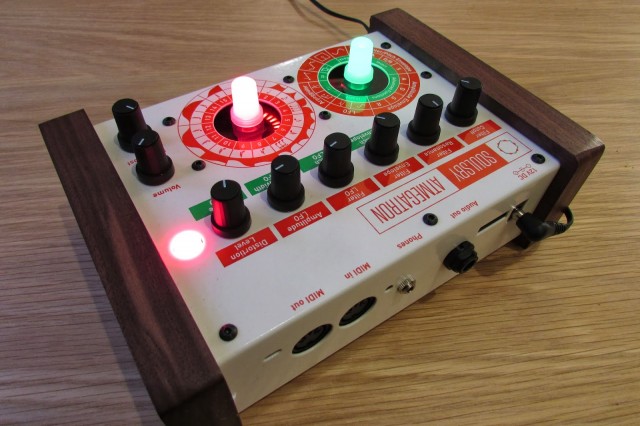Soulsby Synthesizers has finalized the design of the Atmegatron synthesizer – “a revolutionary new synth module that combines classic 8-bit sounds with exciting new features.”
It is expected to be available in February, with PCB and Complete options.
Here’s a sneak preview of the Atmegatron in action:
Here are audio previews:
Designer Paul Soulsby notes that you can do a lot of this in software, but “real synths are great!”
Specifications and other details are to come.
via reader Ben Jarvis


great demos!
Agreed! At first, I didn’t really “get” the whole 8-bit craze, but after hearing some Rubblebucket 8-bit remixes, I’m sold. It digs into our collective Atari video game memory and takes that to another world where bit distortion and aliasing are be-friended. There is something about the brutal high-end that means I can only stand it for about 5 minutes, but otherwise, its cool.
This looks and sounds very cool. Looking forward to seeing the specs on it!
Sounds very nasty ,in the most beautiful way.Tricky disco ‘esque’.
I lookforward to getting my hands on one. What is the price?
Looks like around 255 GBP for the complete synth with case, according to his site.
“Atmegatron Complete – £255 ex VAT. ”
btw those sound samples are kicking my ass
i have a great, work related need for 8-bit hardware atm
everything about it is awesome except the green/red color scheme .. but i can live with that
but fine for the holidays!
Very, very tempted! I’d be even more tempted if he shoved it into a Microbrute-sized keyboard! 😛
Superwant!
This is in fact amazing! Someone has taken 8 bit beyond plastic. The audio demos really show off the device. Sparrows made me think of Bubble Bobble. Don’t have the spare cash at the moment, but if I did……….would have to make a Commando or Moon Patrol remix. Cool stuff, hope you guys sell a million.
i will be buying this evenually… as long as i can sync the lfo’s and arp… that wasn’t mentioned…
Don’t worry, you can! That’ll be in the next vid
Have to admit, the “New Modular Control Keyboard From Synthesizers.com Even Lets You Add A Whammy Bar” picture is not nearly as candid as the one for this product… Marketing FTW!
Yes please.
Can we please stop to use the word “revolutionary”?
Other than that…. WANT!
I find it has an even nicer “brutality” than the micro mini brutes
Great job on the songs guys!
still not clear to me… is fully digital? or does it have any analog components?
Taken from the site:
The Atmegatron is 99% software. But the 1% hardware is very important. This is because the Atmega328P processor doesn’t actually have an analogue audio output. It has a Pulse Width Modulation output. This is one way in which the Atmegatron has a unique sound. To achieve this sound in software, the 65kHz Pulse Width Modulated output would need to be emulated. This output is then filtered and gain/bias adjusted using analogue circuitry. Again this would need emulating in software.
The way the Arduino code works would also need to be emulated in software. There are 2 loops (a loop and an interrupt to be technically accurate!): one updates the output waveform, one does everything else. The way these 2 loops interact is another attribute of the Atmegatron’s unique sound. This would also need emulating in software.
Looks and sounds great. Love the enclosure too. I’d never seen those LED encoders before – very cool. Looked into the LED rings too – ouch they are expensive!
Nice low end…I will buy for sure!!!
Atmegaparty! reminds me of the Miami Vice C64 Theme.
At least a SID with much more bottom end.